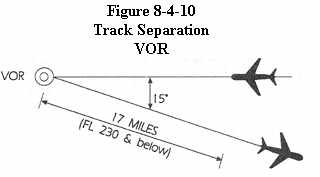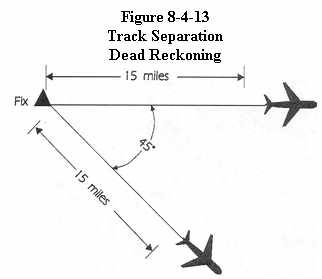
Separate aircraft by assigning different flight paths whose widths or protected airspace do not overlap.
NOTE -
Lateral separation minima is contained in:
Section 7, North Atlantic ICAO Region.
Section 8, Caribbean ICAO Region.
Section 9, Pacific ICAO Region.
Section 10, North American ICAO Region.
Lateral separation exists for:
a. Nonintersecting flight paths:
1. When the required distance is maintained between the flight
paths; or (See Figure 8-4-1)
 |
2. When reduced route protected airspace is applicable, and the
protected airspace of the flight paths do not overlap; or (See Figure 8-4-2)
 |
3. When aircraft are crossing an oceanic boundary and are entering
an airspace with a larger lateral minimum than the airspace being exited;
and
(a) The smaller separation exists at the boundary; and
(b) Flight paths diverge by 15° or more until the
larger minimum is established. (See Figure 8-4-3)
 |
b. Intersecting flight paths with constant and same width protected
airspace when either aircraft is at or beyond a distance equal to the applicable
lateral separation minimum measured perpendicular to the flight path of
the other aircraft. (See Figure 8-4-4)
 |
c. Intersecting flight paths with constant but different width
protected airspace when either aircraft is at or beyond a distance equal
to the sum of the protected airspace of both flight paths measured perpendicular
to the flight path of the other aircraft. (See Figure 8-4-5)
d. Intersecting flight paths with variable width protected airspace
when either aircraft is at or beyond a distance equal to the sum of the
protected airspace of both flight paths measured perpendicular to the flight
path of the other aircraft. Measure protected airspace for each aircraft
perpendicular to its flight path at the first point or the last point,
as applicable, of protected airspace overlap.
 |
NOTE -
In Figure 8-4-5, the protected airspace for Westbound flight A is distance
"a" (50 miles), and for Southwestbound flight B, distance "b" (10 miles).
Therefore, the sum of distances "a" and "b"; i.e., the protected airspace
of A and B, establishes the lateral separation (60 miles) applicable for
either flight relevant to the other.
 |
NOTE -
(See Figure 8-4-6). At the first point of protected airspace overlap,
the protected airspace for Westbound flight A is distance "a" (50 miles),
and for Southbound flight B, distance "b" (40 miles). The sum of distances
"a" and "b" (90 miles) establishes the lateral separation minimum applicable
in this example for either flight as it approaches the intersection. Thus,
for example, B should be vertically separated from A by the time it reaches
point "p."
 |
NOTE -
(See Figure 8-4-7). Distance "a" (50 miles) and "b" (30 miles) are
determined at the last point of protected airspace overlap. The sum of
the distances "a" and "b" (80 miles) establishes the lateral separation
minima applicable for either flight after it passes beyond the intersection.
Thus, for example, B could be cleared to, or through, A's altitude after
passing point "r."
8-4-3 Reduction of Route Protected Airspace
When routes have been satisfactorily flight checked and notice has been given to users, reduction in route protected airspace may be made as follows:
a. Below FL 240, reduce the width of the protected airspace to
5 miles on each side of the route centerline to a distance of 57.14 miles
from the NAVAID, then increasing in width on a 5° angle from the route
centerline, measured at the NAVAID, to the maximum width allowable within
the lateral minima; for example, 50 miles of protected airspace on each
side of centerline; i.e., a lateral minimum of 100 miles. (See Figure 8-4-8)
 |
b. At and above FL 240, reduce the width of the protected airspace
to 10 miles on each side of the route centerline to a distance of 114.29
miles from the NAVAID, then increasing in width on a 5° angle from
the route centerline, as measured at the NAVAID, to the maximum width allowable
within the lateral minima; for example, 60 miles of protected airspace
on each side of the centerline; i.e., a lateral separation minimum of 120
miles. (See Figure 8-4-9)
 |
Apply track separation between aircraft by requiring aircraft
to fly specified tracks or radials and with specified spacings as follows:
a. Same NAVAID:
1. VOR/VORTAC/TACAN. Consider separation to exist between aircraft
established on radials of the same NAVAID that diverge by at least 15 degrees
when either aircraft is clear of the airspace to be protected for the other
aircraft. Use the table to determine the flight distance required for various
divergence angles and altitudes to clear the airspace to be protected.
(See Figure 8-4-10)
Table 8-4-1 - Divergence - Distance Minima
(VOR/VORTAC/TACAN)
-----------------------------------------------------------------
Distance (miles)
-------------------------------------------
Divergence (degrees) FL 230 and below
FL 240 through FL 450
-----------------------------------------------------------------
15 - 25
17
18
26 - 35
11
13
36 - 90
8
11
-----------------------------------------------------------------
Note: This table compensates for DME
slant range error.
 |
2. NDB:
(a) Consider separation to exist between aircraft established
on tracks of the same NAVAID that diverge by at least 30 degrees and one
aircraft is at least 15 miles from the NAVAID. This separation shall not
be used when one or both aircraft are inbound to the aid unless the distance
of the aircraft from the facility can be readily determined by reference
to the NAVAID. Use the table to determine the flight distance required
for various divergence angles to clear the airspace to be protected. For
divergence that falls between two values, use the lesser value to obtain
the distance. (See Figure 8-4-11)
Table 8-4-2
- Divergence - Distance Minima (NDB)
-----------------------------------------------------------------
Distance (miles)
-------------------------------------------
Divergence (degrees) FL 230 and below
FL 240 through FL 450
-----------------------------------------------------------------
30
16
17
45
13
14
60
9
10
75
7
8
90
6
7
-----------------------------------------------------------------
Note: This table compensates for DME
slant range error.
 |
(b) Clear aircraft navigating on NDB facilities in accordance
with paragraph 2-5-2.
b. Different NAVAIDs: Separate aircraft using different navigation
aids by assigning tracks so that their protected airspace does not overlap.
(See Figure 8-4-12)
 |
c. Dead Reckoning (DR):
1. Consider separation to exist between aircraft established
on tracks that diverge by at least 45 degrees when one aircraft is at least
15 miles from the point of intersection of the tracks. This point may be
determined either visually or by reference to a navigation aid. (See Figure
8-4-13)
 |